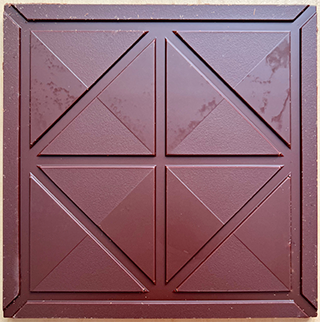
Bean to bar maker 9th & Larkin makes single origin bars in SF’s Dogpatch neighborhood. Their “bars” are actually big 4″ squares of chocolate. Already a distinctive shape, they are wrapped in an eye-catching pattern created by rolling an inked cacao pod on silk. They stand out in any collection of artisan chocolate, so you will want to reach for one, but how to decide which one? The packaging provides no clues other than the cacao’s place of origin and percentage.
Recently, Cacaopod (the CBTB chocolateer, not the plant matter) and I picked up the latest single origins from 9th & Larkin at Market Hall Foods. The TL;DR is that they are all excellent, but different. Read on for descriptions of the differences so you can have some idea of what you are getting in each bar. Plus I highlight an interesting commonality in 9th & Larkin bars.

Before that I have to confess that the mold flummoxed me at first. The bars are big squares, but the mold divides a bar in triangles. So I hesitated: how do I break off a square to sample? Cacaopod had no such qualms and simply broke off a corner, which snapped off as a neat triangle. Then he broke it in half to share. Easy peasy and kinda genius.
If the mold was designed to break in squares, you would have to break off a whole line of squares, then break off a single square. Breaking off corners and proceeding to break off additional triangular pieces is neater, and results in fewer loose pieces. It seems so obvious in hindsight.
With 5 distinctly different bars, these reviews are arranged in order from fruitiest to most savory, AKA safest to most esoteric flavors. You won’t go wrong with any of these bars, but these descriptions could help you choose ones that are the most to your liking.
Fruity
For me, it was the most fruit forward bar that I liked best: The 72% Peru, Ucayali River bar had a hard snap and started with a strong berry flavor that became more tart as it melted, The texture was slightly grainy but not unpleasantly so. The tart berry taste lingered. I have found that Peruvian cacao is generally a crowdpleaser taste-wise with its strong fruitiness, and this bar is a good example of that.

Trendy
The 72% Tanzania bar uses the very popular cacao from the Kokoa Kamili fermentary. The bar had a strong chocolatey smell and medium hard snap. It was a little slow to melt but very flavorful. It started with a strongly fermented taste that turned raisiny and ended with a berry flavor. It was smooth with a sweet fruity lightly chocolate aftertaste. Kokoa Kamili is trendy now for a good reason: Its strongly fermented taste is distinctive and delicious.
Balanced
The 72% Dominican Republic, Zorzal bar had a little bit of everything 9th & Larkin in it. It was a dark brown color with a good snap. It was not sweet but not bitter either and a little grainy. It was mostly fermented tasting with a little berry fruitiness and some smokiness. I felt a mild drying sensation as it melted. The aftertaste was good, mostly fruity tasting.

Complex
The 70% Tien Giang, Vietnam bar was a medium brown color and had the hardest snap of the bunch. It also took a while to melt. When it did start to melt, it tasted nutty and a little smoky, which turned fruity with pear overtones. It was a little drying, but had a fairly smooth texture. It was not very sweet but also not very bitter. The aftertaste was more chocolatey than when it was melting in my mouth.
This was the first bar of the batch we tried, and it struck us both how much more flavorful the aftertaste was. The bar took so long to melt that at first we were thinking it didn’t have much flavor at all. As it started to reveal the different overtones it was more interesting but still didn’t have a satisfying chocolate taste — until it was gone. Then it left a chocolatey aftertaste that lingered. It won us over.
We found this phenomenon in the other 9th & Larkin bars too to differing degrees. The contrast between the in-the-moment taste and the aftertaste was more pronounced in the more savory bars like this one and the next bar, but in all of them the aftertaste was excellent. Even if I didn’t think the experience was chocolatey enough, the aftertaste was great and changed my mind. As Cacaopod said about these bars, “It’s all about the aftertaste.”
Savory
The 74% Fiji, Matasawalevu bar was the furthest from my comfort zone. It had a perfect hard snap, and was so hard and dry that it took a long time to melt and taste like anything. It turned into a savory nutty chocolate. It was more bitter than the other bars, but not unpleasantly so. It started smooth and ended a little grainy, but had a nutty chocolatey aftertaste that we both liked. Again, the aftertaste changed my whole experience of the bar. It took the bar from interesting to delicious.
As with all single origins, your milage might vary. Different batches from the same area can taste different, and unlike couvertures the maker isn’t trying to balance flavors to some consistent taste. Also, bean to bar makers can’t always source cacao from the same place or they discover new beans they want to work with, so these particular bars might not be available when you are ready to try 9th & Larkin. Based on our experience, I would say take a chance on whatever they have to offer. The bars are attractive, well made, interesting and have a seriously good aftertaste.
You can buy 9th & Larkin bars on their website and at some local retailers like Market Hall Foods and Hudson Greens & Goods.



